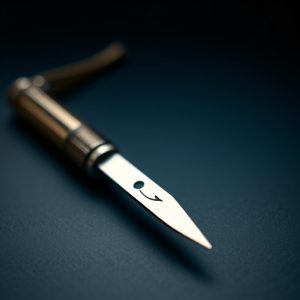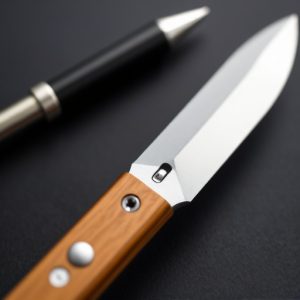Mastering Calligraphy: The Pen with Knife Technique Explored
The 'pen with knife' technique is a highly specialized calligraphic practice that combine…….
The 'pen with knife' technique is a highly specialized calligraphic practice that combines the delicate application of ink with precise carving to create visually stunning and technically precise letters. Originated from ancient civilizations and particularly influential in Islamic calligraphy, this method involves using a pointed pen guided by a flat tool resembling a knife to achieve unparalleled line control and variation in stroke thickness. This technique has been pivotal in the development of Arabic calligraphy's intricate aesthetic, requiring high skill and dexterity from practitioners. The interplay between various tools, including quality paper, a straight knife with a fine point, and a suitable pen nib, is crucial for this art form. Artists must also carefully select ink that does not bleed through or vanish on the paper to ensure the final piece's integrity. The 'pen with knife' technique stands as a testament to the harmony between artistic expression and meticulous craftsmanship in calligraphy, making it an enduring and revered craft within the field.
Embark on a journey into the delicate dance of strokes and incisions as we delve into the intricate world of ‘pen with knife’ calligraphy. This ancient art form, where the precision of a pen meets the finesse of a knife, is not merely a visual spectacle but a testament to the mastery of balance and control. In this comprehensive exploration, we will uncover the origins and significance of the technique, dissect the tools that bring its elegance to life, and guide you through the nuanced steps to master it. From the cultural tapestry that has nurtured its evolution to the cutting-edge innovations redefining its boundaries, ‘pen with knife’ calligraphy is a living tradition that continues to inspire and challenge artists today. Join us as we chart the past, present, and future of this remarkable craft.
The Symbiosis of Artistry and Precision: Unpacking the 'Pen with Knife' Technique
The ‘pen with knife’ technique represents a harmonious blend of artistry and precision, a skill that has fascinated and intrigued enthusiasts for generations. This method, as the name suggests, involves the use of both a pen and a knife in the realm of calligraphy, where each tool plays a pivotal role in creating letters with unmatched elegance and definition. The pen lays down the basic strokes with fluidity, while the knife sculpts and refines these strokes to perfection. This symbiotic relationship between the two tools allows for an intricate dance of line and space, resulting in calligraphic works that embody both grace and exactness.
The artisan who masters the ‘pen with knife’ technique is adept at manipulating the instruments to achieve a level of detail that can transform a mere string of characters into a visual masterpiece. The precision required to wield the knife with control, carefully carving out serifs or adjusting the thickness and thinness of strokes, complements the pen’s smooth flow of ink across the paper. This fusion of tools elevates the craft to an art form, where each letter is a testament to the artisan’s dedication and skill. The ‘pen with knife’ technique, therefore, stands as a paragon of the meticulous marriage between artistic flair and technical precision in the world of calligraphy.
– Exploring the origins and significance of the 'pen with knife' technique in calligraphy
The ‘pen with knife’ technique, a distinct method within the art of calligraphy, has a rich history that extends back to ancient civilizations. This approach involves using a pointed pen that is guided by a flat tool resembling a knife, allowing for precise control over line width and stroke modulation. It is a practice deeply rooted in the Islamic tradition, where it was developed and refined to its current form. The technique gained prominence in various cultures, particularly in the Arabic-speaking world, due to its ability to capture the nuances of the script with unparalleled elegance and fluidity. The ‘pen with knife’ method is not merely a tool for writing but an art form that requires significant skill and dexterity. Calligraphers employ this technique to create calligraphic works that exhibit a harmonious balance between rhythm, flow, and aesthetics, making it a cornerstone of the discipline’s beauty and sophistication. The intricate strokes and the texture they produce are unique to this method, setting it apart from other calligraphic styles and contributing to its lasting significance in the realm of decorative writing. As such, the ‘pen with knife’ technique continues to be celebrated for its artistic merit and is a subject of study and admiration among practitioners and aficionados alike, ensuring its place as an integral aspect of calligraphic heritage.
– Analyzing the tools and materials required for this intricate art form
Crafting a piece that marries the precision of a knife with the finesse of a pen is an art form that demands meticulous attention to detail and a mastery of specialized tools and materials. The process begins with selecting high-quality paper, which must be both durable enough to withstand the incisions made by the knife and smooth enough to allow the ink from the pen to flow evenly without blotching or feathering. The blade used for this task is typically a versatile straight knife, often with a fine point to ensure delicate lines can be executed with ease. Artists often prefer ceramic or high-carbon stainless steel blades for their sharpness and ability to hold an edge, reducing the need for frequent sharpening which could otherwise alter the paper’s surface.
The pen, in this context, is equally critical. A fine point nib is essential for creating thin, controlled lines that complement the knife’s work. The choice of ink is also paramount; it must be of a consistency and flow that aligns with the weight and texture of the paper. Ink that is too thick may bleed through the page, while ink that is too thin might not show up clearly next to the incisions made by the knife. Practitioners often experiment with different types of nibs—flexible or oblique—and various inks to achieve the best outcome for their work, which can range from intricate patterns to detailed illustrations. The combination of these tools and materials, when used skillfully, allows for the creation of unique artworks that are both visually striking and tactilely engaging, blending the seemingly disparate techniques of drawing and carving into a harmonious final piece.


